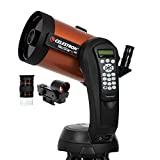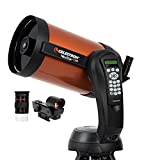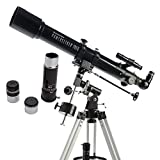Telescopes from Celestron – Buying Guide & Comparison
Whether you’re an amateur stargazer or an experienced astronomer looking to find the best telescope from Celestron, we’re here to help. We know that browsing through dozens of pages with technical info on each of the plethora of telescope models can be time-consuming, and this is why we have done the job for you. Celestron is a legendary brand which popularized the telescope and brought it to the masses. While it has many great models for sale, we have found that the Celestron NexStar 6 is the best when considering technical specs, features, and price. It comes with the latest coatings on its glass components, has a large 6-inch aperture, a GoTo mount with a database of 40,000 objects, an easy to use fork mount as well as quality eyepieces and other accessories. In case this model runs out of stock, then you should definitely consider the Celestron NexStar 8.
Comparison table
 Our Top Choice
Our Top Choice
You will be able to study the moon, nearby planets, and even nebulae with the help of this model that comes equipped with a 6-inch aperture. Users can take full advantage of the GoTo mount and the database of 40,000 objects that can easily be located and observed even by a novice astronomer. Another thing you will like about this model is the SkyAlign technology that lets you use locations of bright objects to identify others.
There is no auto-aligning, and that can be a bother for some.
A good instrument to observe the night sky, especially if you are a beginner.
 2nd Best
2nd Best
Many people who have already bought and used this model are more than pleased with how far the telescope can reach. An entirely new world will open up in front of you as you examine the night sky using this unit that comes with an 8-inch aperture for bright images, and a focal length of 80 inches. Make great use of the 40,000 sky locations included with the GoTo mount that is one of the reasons why so many novices are in love with this model.
The battery drains fast, and you might need to buy an adapter.
An option for exploring far away galaxies and nebulae, along with the solar system planets.
Also To Consider
The long focal length ensures that you will be able to reach far and explore celestial bodies to your heart’s content. The fully-coated optics are part of what makes this model good value for the money. The lenses will provide you with a clear image, and even when you use high magnification, you will not have to worry about chromatic aberrations. The included astronomy software contains 10,000 locations.
The accessories included are not on par with the telescope.
Excellent value for the money, the telescope offers high performance.
Finding a good Celestron telescope can be tough these days, with so many things to compare between models, such as focal length, aperture and mounts, and so many Celestron telescope reviews to read. If these terms confuse you, or you simply don’t have the time to do a lot of reading, then you should be glad to learn that we have compiled a short guide which should help you find the best telescope for your needs and budget without allocating dozens of hours to do your own research.
Apertures and image quality
One of the main technical details you often hear about when looking for a telescope is the aperture. This can be described as the diameter of the main mirror or lens which captures light bounced by bright objects. The larger the aperture, the more light can the telescope capture, resulting in brighter images. But brightness isn’t the only benefit to a large aperture, as its size is also directly related to the level of details. A telescope with a larger aperture will be able to resolve more details, thus have a higher resolution with better and sharper details.
But depending on what you want to study as well as your budget, you don’t need to spend huge amounts of money only to get a large aperture telescope. The quality of components also contributes to resolution power, as finely-ground glass mirrors will bring out more detail while being more expensive than lower-quality glass components.
Magnification explained
While this may surprise you, the aperture of any given telescope does not affect magnification. What does affect magnification is the focal length of the telescope or lens and the eyepieces you use.
The focal length is the distance between the main lens through which light enters the telescope and the focal plane where the image is formed. This distance is usually measured in millimeters. So a 700 telescope has a focal length of 700 millimeters or 28 inches. Eyepieces have their own focal lengths. The magnification or power of any given telescope is obtained by dividing the focal length of the lens by that of the eyepiece. A 500-millimeter telescope with a 25 mm eyepiece will have a standard magnification of 20.
You can always increase magnification by adding an eyepiece with a shorter focal length. However, you should try not to exceed the maximum useful magnification, which is usually double the aperture number in millimeters or 50 times higher than its value in inches.
Stability is important
With telescopes, it doesn’t matter how large the aperture is or how much magnification you have if you don’t have a stable mount. Without a solid base to rest the telescope on, the image will not only shake in all directions, but it would also be challenging to hold a specific object in the field of view or focus properly.
Fortunately, many telescope models come with great mounts which allow you to easily track celestial objects and to lock on them while also taking into account Earth’s movement.
5 Best Celestron Telescopes (Reviews) in 2024
By getting the right telescope, you will be able to admire Moon’s craters, Saturn’s rings and even far-away objects such as other solar systems, nebulae, and distant galaxies. We have compiled a list of top rated models on the market so that you get to choose the best Celestron telescope to satisfy your passion.
Contents
1. Celestron 11068 NexStar 6 SE Computerised Telescope

With this model, you also get a fully computerized GoTo mount which contains a database of a whopping 40,000 celestial objects that it can automatically locate and track. You also get to align your telescope easily by using 3 single bright objects, thanks to the new SkyAlign technology.
You can dismantle the steel tripod, and single-arm fork mount into smaller parts, and that, combined with the compact body of the telescope, should allow you to carry it with you anywhere with ease.
Pros
With the help of this model and its 6-inch aperture, you will be able to closely inspect the Moon in high detail and observe the planets in our solar system.
You will also get a computerized GoTo mount containing a database of 40,000 celestial bodies which you can locate and track.
Due to the innovative SkyAlign technology, you can easily align the telescope by using three single bright objects.
In case you need to carry the unit around, you can dismantle the steel tripod, and single-arm fork mount into smaller sections.
This model is a great instrument to study the night sky, and it is suitable even if you are a beginner.
Cons
The fact that there is no auto-aligning can be a bother for some users.
A few buyers also had a bit of trouble setting the device up, and could not get around with the provided instructions alone.
Buy from Amazon.com
2. Celestron 11069 NexStar 8 SE Computerised Telescope

Thanks to the GoTo mount, you have the opportunity to view nearly 40,000 celestial objects, and the best part is that the telescope can find and locate any of these for you.
With the standard 25 mm eyepiece, you get to enjoy a magnification of 81x, with a maximum of 480 x useful magnification, opening up the sky to plenty new opportunities to observe. With a compact body and foldable mount and tripod, the Celestron NexStar 8 is the perfect companion to delight yourself either on trips or at home.
Pros
Offering a long focal length, this telescope is a great alternative for nurturing your star-gazing passion.
You will be able to see distant celestial objects at great magnification due to the 80-inch lens focal length. The telescope gathers much light and provides clear images with fine details.
Equipped with the GoTo mount, you get to view around 40,000 celestial objects, while the telescope can find and locate any of them.
The standard 25mm eyepiece offers a magnification of 81x, with a maximum of 480x useful magnification.
You can consider this unit as an ideal option for trips as well, since it has a compact body and a foldable mount and tripod.
Cons
According to some owners, the battery drains fast, so it is recommended to buy an adapter.
Although it is easy to set up and move the telescope, it can take longer if you are doing this alone.
Buy from Amazon.com
3. Celestron 21037 PowerSeeker 70EQ Refractor Telescope

With a 70 mm or 2.76-inch aperture, this telescope is able to gather plenty of light and offer a good amount of detail even on distant planets, while the fully-coated glass components will further increase the image quality and remove chromatic aberrations and other optical defects.
With a 20-mm eyepiece, you benefit from 35 x magnification, while the 3x Barlow lens will triple that and make all objects appear even closer. The Celestron PowerSeeker 70EQ also comes with astronomy software which contains a database of 10,000 objects as well as several printable sky maps which are perfect for beginners.
Pros
If you are a beginner, this model is a great option. You will be able to enjoy distant celestial objects due to the long focal length of 28 inches.
Having an aperture of 2.76 inches, this unit can gather a large amount of light and offer many details even from distant planets.
The fully-coated glass elements can increase the image quality and reduce chromatic aberrations and optical defects to a minimum.
You can get a 35x magnification with a 20mm eyepiece, but the 3x Barlow lens triples this, making all objects appear closer.
This telescope comes with an astronomy software containing a database of 10,000 objects and a number of sky maps that are also printable. It is ideal for beginners as well.
Cons
One downside of this model could be that the included accessories are not on par with the unit.
Also, some customers did not find it easy to set up the device.
Buy from Amazon.com
4. Celestron 21037 PowerSeeker 70EQ Refractor Telescope

You get a 15 x magnification factor which is more than enough to observe the Moon or planets in our solar system, as well as some distant objects. This model is actually a Newtonian reflector, using a reflector optical tube instead of glass elements which makes it cheap, yet still able to provide good quality imagery.
The Celestron FirstScope is also lightweight, and thanks to its table-top design, you can easily transport it or store it in your car and ensure that you get to enjoy great moments no matter where you go.
Pros
This model is the perfect choice for beginners, mostly because it is compact and very easy to use.
It comes equipped with a 76 mm optical tube, which is able to deliver remarkable details. And you get all this at a low price!
The 15x magnification factor allows you to observe the Moon, other planets from our solar system and also other distant objects as well.
The unit uses a reflector optical tube instead of glass components. This makes an affordable price possible, yet it provides adequate images.
Thanks to its tabletop design and also being lightweight, the telescope is very easy to transport.
Cons
If you are used to a professional telescope, this model will not satisfy you, as it is intended for beginners.
Some users recommend purchasing a moon filter, as the Moon appears too bright without it.
Buy from Amazon.com
5. Celestron 31042 AstroMaster 114EQ Reflector Telescope

This model is easy to setup and use. You don’t need any tools to start watching your favorite planets or terrestrial objects. Equipped with a German Equatorial mount, this telescope can accurately locate as well as track sky objects while the sturdy steel tripod provides a stable and solid platform to improve accuracy and image clarity.
All glass components are coated using the latest technologies, removing chromatic aberrations and other imperfections while ensuring that you get crystal clear details on far away objects. You also get to use the mounted StarPointer as well as the comprehensive database which contains sky maps, 10,000 objects as well as 75 enhanced images.
Pros
In case you are an astronomy enthusiast, this 39-inch telescope is perfect for you. The 4.49-inch aperture can gather enough light to allow you to observe the Moon and its craters in high detail.
This model is very easy to set up and use, and it does not require any tools to assemble.
The German Equatorial mount allows the telescope to locate and track celestial objects. At the same time, the reliable steel tripod offers a stable and sturdy platform.
The glass elements are fully-coated using the latest technologies, which helps remove any chromatic aberrations and imperfections.
The StarPointer is a database with 10,000 objects and 75 enhanced images that you can use.
Cons
Collimation can be done only using collimation caps, but the included one does not fit the eyepiece well.
The tripod is not as stable as some users might like, and you need to handle the telescope with care.
Buy from Amazon.com











